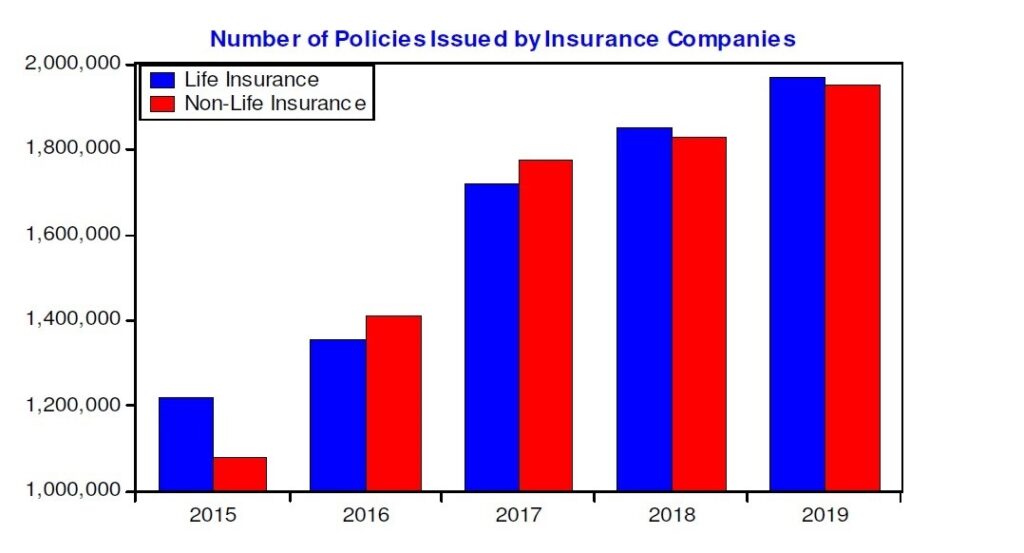In IELTS Writing Task 1 test, you have to understand, interpret, and communicate all sorts of diagrams ranging from statistical graphs to flow charts.
Out of the total 1 hour time for the Writing test, you should spend one-third of it, or 20 minutes, on IELTS Writing Task 1. During this time, you have to select the main features from the image and report on them. In one sense, such questions could be understood as news articles, which aim to objectively cover facts.
Look at an example IELTS Writing Task 1 question below:
WRITING TASK 1
You should spend about 20 minutes on this task.
| The chart below shows the number of insurance policies issued by insurance companies in Nepal from 2015 to 2019. Summarize the information by selecting and reporting the main features, and make comparisons where relevant. |
Write at least 150 words.

Types of questions in IELTS Writing Task 1
There are six main types of images which could appear in the IELTS Writing Task 1.
So, the images in IELTS Writing Task 1 could have statistical, procedural, or geographical information. Any other type of image, such as photographs or paintings, are not given in IELTS Writing Task 1.
The images could be especially created for the test by Cambridge Assessment English or adapted from books or newspapers.
It is advisable that candidates regularly check out different forms of diagrams which are published in newspapers so as to familiarize themselves with such images.
Answer format for IELTS Writing Task 1
In the test, we get 20 minutes for answering the IELTS Writing Task 1 question. I believe the first 3 to 4 minutes should be spent on understanding and analyzing the image. Then, you should write your response in about 15 minutes. Finally, spare 1 to 2 minutes for proofreading.
The answer for IELTS Writing Task 1 should be divided into three parts as follows:
| Parts | |
|---|---|
| 1. Introduction | A short paragraph describing what the image is. |
| 2. Overview | A short paragraph summarizing the overall trend from the image. |
| 3. Description | One or more paragraphs reporting on the data or features of the image. |
A comprehensive tutorial on how to write a complete response will be incorporated in the lessons to follow. But for now, let’s look at a sample answer for the question from earlier.
| Sample answer: |
|---|
| The given bar graph provides information about the number of insurance policies sold in Nepal between 2015 and 2019. To sum up, there were vast growths in the issuance of both life insurance and non-life insurance policies in Nepal over the period. While the surges were more drastic between 2015 and 2017, the increase of insurance policies had slowed towards the end. We can see that approximately 1.2 million life insurance policies were sold in Nepal in the year 2015. By 2017, there was a marked improvement in this figure, and the total number of life insurance policies issued had reached around 1.7 million. The number of customers had kept on rising and by 2019, slightly under 2 million life insurance policies had been issued in Nepal. Furthermore, although the number of non-life insurance policies issued in Nepal stood at around 1.1 million in 2015, like life-insurance, its takers also skyrocketed in the following four years. In fact, in 2016 and 2017, more non-life policies were sold in Nepal than life insurance. At the end, insurance companies in Nepal had issued about 1.9 million non-life insurance policies. |
Essential features of answers for IELTS Writing Task 1
Like we have discussed before, there are four criteria for the evaluation of Writing tasks in the IELTS tests.
Task achievement
The inclusion or omission of key features from the IELTS Writing Task 1 image in the answer is the primary thing which is judged. All the main aspects of the image, including important data, trends, and main stages, have to be presented in a clear language.
If the details are inaccurate or irrelevant, then the score will suffer.
Additionally, an overview paragraph, which summarizes the key features of the image, must be present.
Coherence and cohesion
As we write at least 150 words for IELTS Writing Task 1 question, you should bear in mind that all the 150 words have to be linked together to form one complete response.
Therefore, the words have to be combined appropriately in sentences and then paragraphs in a logical structure rather than haphazardly. For this, cohesive devices and discourse markers should be used so that our answer is easy to read and understand.
Here is a list of some common cohesive devices you could use in IELTS Writing Task 1.
Adding information
| Likewise | Similarly | Moreover |
| Furthermore | Additionally | On top of that |
| Apart from that | Also | Beyond that |
| Besides | In addition | What is more |
Comparing and contrasting
| However | On the other hand | In contrast |
| By comparison | Meanwhile | Nevertheless |
| Nonetheless | Whereas | Conversely |
Linking ideas
| We can see that | We can also notice that |
| It is evident from the diagram that | It can be deduced that |
| It is clear that | The graph also shows that |
Lexical resource
You need to learn a wide range of technical words which convey precise meaning for securing high marks in the IELTS Writing Task 1.
Repetition of a limited number of words, using words in wrong contexts, and making frequent spelling errors will result in a lower score.
As a general rule of thumb, you should read newspapers, especially news articles based on statistical reports, to equip yourself with academic and formal words to describe data, trends, and processes.

You may like:
Complex sentences
In grammar, complex sentences refer to a specific sentence structure and not just sentences which are difficult to understand.
Consider this sentence:
The temperature dropped.
This sentence has one subject (The temperature) and one verb (dropped). Such sentences with just one verb are usually called simple sentences.
Consider these two simple sentences:
The temperature dropped. People can be seen wearing warm clothes.
There are multiple ways of combining two related simple sentences. One method is by using a conjunction (for, and, nor, but, or, yet, so).
Look at the following sentence which combines the two sentences from earlier into one long sentence.
The temperature dropped, so people can be seen wearing warm clothes.
When two simple sentences are joined using a conjunction, a compound sentence is formed.
But there is another way to combine simple sentences. Consider the next example:
Since the temperature dropped, people can be seen wearing warm clothes.
This is a complex sentence. In this example, the word “Since” is used in the beginning in order to avoid having to use a conjunction. A comma separates the two parts of the sentences. The part before the comma states a cause and the part after the comma describes the effect. Also notice that if we divide the sentence into two parts by putting a full-stop (or period) instead of the comma, we get this:
Since the temperature dropped. People can be seen wearing warm clothes.
The first sentence is incomplete. It is dependent upon the second part so as to complete the meaning. Such clauses (phrases) are called dependent clauses.
However, the second sentence is a complete sentence. It does not rely upon the first to give meaning. It can stand alone as a grammatically correct sentence. Such clauses are called independent clauses.
Therefore, a complex sentence is a sentence with one dependent clause and one independent clause. If both the clauses in the sentence are independent, then such a sentence would be a compound sentence. One part should be dependent and the other independent for a complex sentence.
Examples of complex sentences
Although the sales of life insurance policies increased, the sales of vehicle insurance declined.
Even though travelling has become cheaper, the number of tourists has not risen in this area.
In addition to home ownership, the rate of gun ownership has jumped.
Apart from the decline in income levels, the people have been affected by massive droughts over the last decade.
Due to the new rules regarding social distancing, tables in the restaurant have been kept at least 6 feet apart.
In order to understand the underlying causes of poverty, a comprehensive research has to be commissioned.
When there was a fall in profits, the company decided to lay off hundreds of workers.
Because of poor visibility, the flights to Abu Dhabi were cancelled.
During the first half of the period, heavy industry grew rapidly in the west of the region.
In all the examples above, the first part of the sentences before the comma are dependent clauses. They need the second part to realize their meaning.
Please note: It is not necessary to always have dependent clause in the beginning of sentences and independent clause at the end. But in the examples above, this has been done to make the concept clearer by using the comma as a separator. A reversal of the order of the two clauses and removal of the comma still creates complex sentences. For an instance, The sales of life insurance policies increased although the sales of vehicle insurance declined.
You have to practice creating such complex sentences because it might be very difficult to write in such sentences naturally. You can follow the sentence structures of the examples above. To get a good score in the IELTS Writing Task 1, it is compulsory that you use complex sentences.
Next lesson:
quite helpful
Thanks buddy!